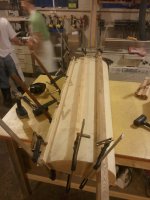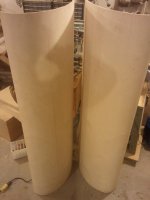Some ways I did it:
Some of the construction pictures.
Made up of 3mm Baltic Birch plywood bent over a curved form.
Some of the construction pictures.
Made up of 3mm Baltic Birch plywood bent over a curved form.
Attachments
I guess it would be an accurate visual representation of an axisymmetric (round) horn,
Just to clarify - the Hornresp schematic diagram will be shown correctly scaled provided that the display monitor screen pixels are square. In other words, the chosen screen resolution needs to be consistent with the aspect ratio of the display monitor. If not, the picture will be elongated or compressed in either the horizontal or vertical direction.
For example, if the display monitor has a screen aspect ratio of 16 : 9 then a compatible resolution would be 1280 x 720 pixels. A resolution of 1280 x 1024 pixels on the same monitor would show the schematic diagram to be elongated horizontally.
Kind regards,
David
I finally fired up Hornresp for the first time, had it for years on the HD. 😱
Thanks Mr. McBean! 😎
Good point on the screen aspect ratio.
Thanks Mr. McBean! 😎
Good point on the screen aspect ratio.
In any case, I would trust the exported data more than the schematic.
Further to Bjørn’s post:
1. The Hornresp standard exported data for a Le Cléac'h horn will generate a profile identical to that shown in the schematic diagram. The maximum permitted mouth flare tangent angle is 180 degrees. Both the schematic diagram and the standard exported data are calculated using Jean-Michel’s 2007 profile.
2. The Hornresp optional "exact profile" exported data for a Le Cléac'h horn produces a slightly different but theoretically more accurate profile for an axisymmetric horn. The profile is by default automatically generated out to a mouth flare tangent angle of 360 degrees.
3. The attached screenprint shows the difference between Jean-Michel’s 2007 "improved" profile (blue curve) and the more accurate "new" exact profile (green curve). Note the subtle differences near the mouth.
4. See http://www.diyaudio.com/forums/multi-way/140190-jean-michel-lecleach-horns-114.html#post2619419 for further background information.
5. It is recommended that the theoretically "exact" profile data be used when constructing an axisymmetric Le Cléac'h horn - simply truncate the mouth at the desired flare tangent angle, if less than 360 degrees.
Kind regards,
David
Attachments
I finally fired up Hornresp for the first time, had it for years on the HD.
Hi Bart,
In that case it is probably worth downloading a copy of the latest release, before going too far 🙂.
Kind regards,
David
Yes, I thought of that, lol.
Now I'm busy trying to design a bass-reflex. I'm getting loads of help from a forum member trough E-mail.
Using the program is one thing, but understanding what's on display is something else. So, lucky me to have an experienced member wanting to put time and effort into a novice.
Now I'm busy trying to design a bass-reflex. I'm getting loads of help from a forum member trough E-mail.
Using the program is one thing, but understanding what's on display is something else. So, lucky me to have an experienced member wanting to put time and effort into a novice.
David, thanks a lot. Now its more clear for me.
Does 360 degree profile have some advantages over less tangent? 180 for example?
Does 360 degree profile have some advantages over less tangent? 180 for example?
Last edited:
Just to clarify - the Hornresp schematic diagram will be shown correctly scaled provided that the display monitor screen pixels are square. In other words, the chosen screen resolution needs to be consistent with the aspect ratio of the display monitor. If not, the picture will be elongated or compressed in either the horizontal or vertical direction.
For example, if the display monitor has a screen aspect ratio of 16 : 9 then a compatible resolution would be 1280 x 720 pixels. A resolution of 1280 x 1024 pixels on the same monitor would show the schematic diagram to be elongated horizontally.
That makes sense. Because I'm working on a 32 inch 16:9 Monitor/TV
Hi, David! Thank you for your program! It did quality breakthrough in world of Horn speaker building enthusiasts!
I have a question and/or proposal.
How I can simulate an offset port? The hornresp have an ability to calculate an "Offset speaker" system, but what i must do to simulate speaker with offset port, like PMC GB1i (in attachment) ?
Maybe it makes sense to add an "Offset Port" and "Offset Speaker and Port" modes, not only the "Offset Speaker" mode?
Thank You.
Alexander Rogozhin.
I have a question and/or proposal.
How I can simulate an offset port? The hornresp have an ability to calculate an "Offset speaker" system, but what i must do to simulate speaker with offset port, like PMC GB1i (in attachment) ?
Maybe it makes sense to add an "Offset Port" and "Offset Speaker and Port" modes, not only the "Offset Speaker" mode?
Thank You.
Alexander Rogozhin.
An externally hosted image should be here but it was not working when we last tested it.
Yes, I support Rogozhin`s request. Also wanted always to have opportunity to simulate offset port.
Does 360 degree profile have some advantages over less tangent? 180 for example?
I did a study of this some time ago, using BEM (a more accurate, but much slower method that what Hornresp uses), and increasing the rollback has some effect on the smoothness of the response. See the results here: BEM Simulations
Regards,
Bjørn
Does 360 degree profile have some advantages over less tangent? 180 for example?
Hi Charcoal,
A Le Cléac'h horn should ideally have a mouth flare tangent angle of at least 180 degrees.
As can be seen from Bjørn’s BEM study, there is little to be gained practically in going beyond 180 degrees.
Kind regards,
David
How I can simulate an offset port?
Hi Alexander,
The e-mail reply I sent to you on 2 October 2012, reproduced below, still applies 🙂.
"Unfortunately it is not possible to specify an offset port design in Hornresp. What you can do though, is to specify the basic design without an offset port, export the data as an AkAbak script file, and then add the offset port details yourself in AkAbak."
Download - Akabak
Kind regards,
David
Hi, David! Unfortunately did not receive your letter, so, thanks for your answer here! Try to do this.
One more question, if you do not mind.
Don't you plan to make the possibility to simulate the effect of filling not only in the rear chamber, but also in the horn?
Alexander.
One more question, if you do not mind.
Don't you plan to make the possibility to simulate the effect of filling not only in the rear chamber, but also in the horn?
Alexander.
Hi Alexander,
That is very strange - normally I get a Postmaster message back advising me if an e-mail I send is not delivered successfully. I had "replied" to the question you asked, so my response should have gone direct to your 'rambler' address. I make a point of answering every e-mail I receive from Hornresp users - even when I know my reply may not be what they were hoping to hear 🙂.
It is highly unlikely that Hornresp will ever allow acoustic filling in the horn. While it might be okay for transmission line type speakers, as far as I am concerned it has no place in a well-designed horn system - artificially introducing a loss in the acoustic path seems to defeat the whole purpose of the exercise 🙂.
Kind regards,
David
Unfortunately did not receive your letter,
That is very strange - normally I get a Postmaster message back advising me if an e-mail I send is not delivered successfully. I had "replied" to the question you asked, so my response should have gone direct to your 'rambler' address. I make a point of answering every e-mail I receive from Hornresp users - even when I know my reply may not be what they were hoping to hear 🙂.
Don't you plan to make the possibility to simulate the effect of filling not only in the rear chamber, but also in the horn?
It is highly unlikely that Hornresp will ever allow acoustic filling in the horn. While it might be okay for transmission line type speakers, as far as I am concerned it has no place in a well-designed horn system - artificially introducing a loss in the acoustic path seems to defeat the whole purpose of the exercise 🙂.
Kind regards,
David
Last I checked it's called Hornresp not TLresp... 😛 🙁
You might ask bjorno if the MJK worksheets will do this...
You might ask bjorno if the MJK worksheets will do this...
It's true, Hornresp is an excellent tool, but a specialized tool for what you are doing is a better choice. Hornresp assumes no losses, and for what you are doing how you manage the resonance and losses matters, if sound quality is a primary concern IMO.
If yI made tens of vrious TLs with Resp and know exactly how the simulation correlates with final result, and results stable, repeatable and as expected, why should I search other soft? I am satisfied.
- Home
- Loudspeakers
- Subwoofers
- Hornresp




